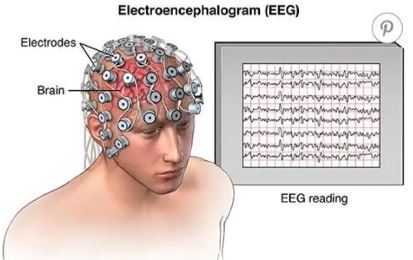From UPSC perspective, the following things are important :
Prelims level: EEG and its working

Why in the News?
This year marks the 100th anniversary of the first human electroencephalography (EEG) by German physiologist Hans Berger.
Historical Development of EEG
|
What is EEG?
- EEG stands for electroencephalography. “Electro” means electricity, “encephalo” refers to the brain, and “graphy” means recording.
- It tracks the electrical activity in the brain that happens when neurons, the brain’s cells, move tiny charged particles.
- This helps doctors tell if the brain is working normally or not.
- Doctors use EEG to diagnose epilepsy, check how deep a person is under anesthesia, study sleep patterns, and even confirm if a person has passed away.
Understanding Volume Conduction
- Volume conduction explains how the brain’s electrical signals move through different layers like skin and bone to reach the electrodes on the scalp.
- The signals that electrodes pick up need to be cleaned up from any distortions caused by these layers or other noises before doctors can read them accurately.
How does an EEG Test Works?
- Neurons interact with their surroundings and sometimes push ions around.
- This movement creates waves of electrical activity.
- Electrodes on the head detect these waves and measure how strong they are, which is then recorded as an EEG.
- Setting up an EEG involves putting gel on the head and placing electrodes accurately, which can be affected by things like having thick hair.
What EEG Can and Can’t Show?
- Strengths: EEG is very good at catching fast changes in the brain’s electrical activity, which is helpful for immediate observations.
- Limitations: It mainly detects signals from the surface of the brain and is better at picking up signals from certain types of cell parts than others.
- Pinpointing exactly where the brain an activity started can be difficult.
Cost and Accessibility
- EEG is simple and affordable compared to other methods like MRI.
- It’s portable, doesn’t use large equipment, and is safe.
PYQ:[2015] With reference to ‘Near Field Communication (NFC) Technology’, which of the following statements is/are correct? 1. It is a contactless communication technology that uses electromagnetic radio fields. 2. NFC is designed for use by devices which can be at a distance of even a metre from each other. 3. NFC can use encryption when sending sensitive information. Select the correct answer using the code given below: (a) 1 and 2 only (b) 3 only (c) 1 and 3 only (d) 1, 2 and 3 |
Get an IAS/IPS ranker as your 1: 1 personal mentor for UPSC 2024
